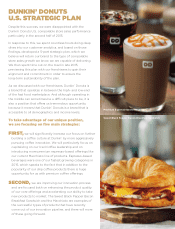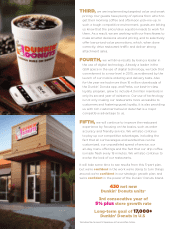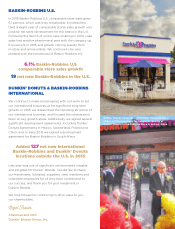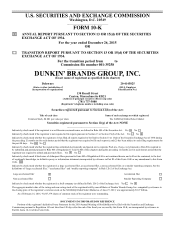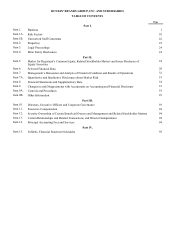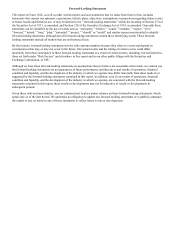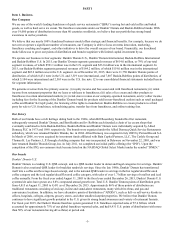Dunkin' Donuts 2015 Annual Report Download - page 12
Download and view the complete annual report
Please find page 12 of the 2015 Dunkin' Donuts annual report below. You can navigate through the pages in the report by either clicking on the pages listed below, or by using the keyword search tool below to find specific information within the annual report.-2-
Baskin-Robbins-U.S.
Baskin-Robbins is one of the leading QSR chains in the U.S. for servings of hard-serve ice cream and develops and sells a full
range of frozen ice cream treats such as cones, cakes, sundaes and frozen beverages. Baskin-Robbins enjoys 89% aided brand
awareness in the U.S., and we believe the brand is known for its innovative flavors, popular “Birthday Club” program and ice
cream flavor library of over 1,300 different offerings. Additionally, our Baskin-Robbins U.S. segment has experienced
comparable store sales growth in each of the last five fiscal years. We believe we can capitalize on the brand’s strengths and
continue generating renewed excitement for the brand. Baskin-Robbins’ “31 flavors,” offering consumers a different flavor for
each day of the month, is recognized by ice cream consumers nationwide. For fiscal year 2015, the Baskin-Robbins franchise
system generated U.S. franchisee-reported sales of approximately $582 million, which accounted for approximately 6% of our
global franchisee-reported sales. Total U.S. Baskin-Robbins points of distribution declined from 2,780 at August 31, 2005 to
2,503 as of December 26, 2015.
International operations
Our international business is primarily conducted via joint ventures and country or territorial license arrangements with “master
franchisees,” who both operate and sub-franchise the brand within their licensed areas. Increasingly, in certain high potential
markets, we are migrating to a model with multiple franchisees in one country, including markets in the United Kingdom,
Germany, China, and Mexico. Our international franchise system, predominantly located across Asia and the Middle East,
generated franchisee-reported sales of $2.0 billion for fiscal year 2015, which represented approximately 19% of Dunkin’
Brands’ global franchisee-reported sales. Dunkin’ Donuts had 3,319 restaurants in 42 countries (excluding the U.S.),
representing $678 million of international franchisee-reported sales for fiscal year 2015, and Baskin-Robbins had 5,104
restaurants in 47 countries (excluding the U.S.), representing approximately $1.3 billion of international franchisee-reported
sales for the same period. From August 31, 2005 to December 26, 2015, total international Dunkin’ Donuts points of
distribution grew from 1,775 to 3,319, and total international Baskin-Robbins points of distribution grew from 2,856 to 5,104.
We believe that we have opportunities to continue to grow our Dunkin’ Donuts and Baskin-Robbins concepts internationally in
new and existing markets through brand and menu differentiation.
Overview of franchising
Franchising is a business arrangement whereby a service organization, the franchisor, grants an operator, the franchisee, a
license to sell the franchisor’s products and services and use its system and trademarks in a given area, with or without
exclusivity. In the context of the restaurant industry, a franchisee pays the franchisor for its concept, strategy, marketing,
operating system, training, purchasing power, and brand recognition. Franchisees are solely responsible for the day-to-day
operations in each franchised restaurant, including but not limited to all labor and employment decisions, such as hiring,
promoting, discharging, scheduling, and setting wages, benefits and all other terms of employment with respect to their
employees.
Franchisee relationships
We seek to maximize the alignment of our interests with those of our franchisees. For instance, we do not derive additional
income through serving as the supplier to our domestic franchisees. In addition, because the ability to execute our strategy is
dependent upon the strength of our relationships with our franchisees, we maintain a multi-tiered advisory council system to
foster an active dialogue with franchisees. The advisory council system provides feedback and input on all major brand
initiatives and is a source of timely information on evolving consumer preferences, which assists new product introductions and
advertising campaigns.
Unlike certain other QSR franchise systems, we generally do not guarantee our franchisees’ financing obligations. From time to
time, at our discretion, we may offer voluntary financing to existing franchisees for specific programs such as the purchase of
specialized equipment. As of December 26, 2015, if all of our outstanding guarantees of third party franchisee financing
obligations came due, we would be liable for $2.0 million. We intend to continue our past practice of limiting our guarantee of
financing for franchisees.
Franchise agreement terms
For each franchised restaurant in the U.S., we enter into a franchise agreement covering a standard set of terms and conditions.
A prospective franchisee may elect to open either a single-branded distribution point or a multi-branded distribution point. In
addition, and depending upon the market, a franchisee may purchase the right to open a franchised restaurant at one or multiple
locations (via a store development agreement, or “SDA”). When granting the right to operate a restaurant to a potential
franchisee, we will generally evaluate the potential franchisee’s prior food-service experience, history in managing profit and
loss operations, financial history, and available capital and financing. We also evaluate potential new franchisees based on
financial measures, including liquid asset and net worth minimums for each brand.




